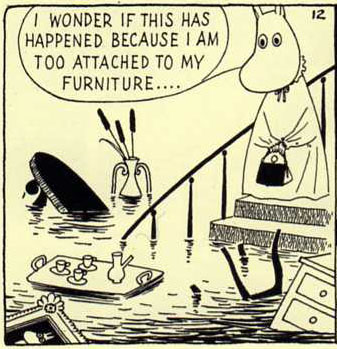I live in a town with horrible traffic issues. I know… who doesn’t? And over the years, I’ve come to the conclusion that I’d rather drive 20 miles out of my way and keep moving than sit in traffic go nowhere, or worse, frequently stop and start without making any meaningful forward progress.
I don’t read that many pamphlet comics, and I think there’s some carry-over from my disposition as a motorist. Not too long ago, I tried a monthly comic that had gotten very good reviews, and I may someday enjoy it in collected form, but the two issues I picked up on the same shop visit confirmed that 20-odd pages with ads is not a satisfying delivery system for me.
In fact, the advertisements almost made me lose my mind. Here’s the breakdown for the first issue, with actual content in italics:
Cover.
Inside cover advertisement.
Four pages of story.
Two pages of advertisements.
Four pages of story.
Two pages of advertisements.
Four pages of story.
Two pages of advertisements.
Four pages of story.
Two pages of advertisements.
Six pages of story.
Two pages of advertisements.
Back inside cover advertisement.
Back cover advertisement.
The four-two-four-two pattern was positively Zen-like compared to the jumble of the second issue. At one point, one page of story was sandwiched between two pages of advertisements. I imagine this is because there were a certain number of advertisers who wanted right-side pages, which forced the layout department to hack up the story in a way that would accommodate the advertisers. But seriously, just throw the page in the trash, why don’t you? Its contents are 90% lost anyways.
I get that it’s a business and some publishers who deal in pamphlet comics rely on advertising revenue, but I found the constant stop-and-start maddening. At least television producers can rely on commercial breaks coming at regular intervals and they can write their beats accordingly. They can even build internal cliffhangers into a half-hour or hour-long program and use the interruptions to their advantage.
But how is a comic writer supposed to know how their story will flow after the ads are inserted in ways that have nothing to do with narrative momentum or even logic? Why would writers even try, unless they were doing some work-for-hire product tie-in where it’s all advertising to begin with? (“Now, after those three pages, there’s a maze where Grimace has to find the three daily servings of fruit.”) And how’s an artist supposed to know that their illustrations stand a chance of leading the reader’s eye in the way they want when one of their sequences is bound to be chopped into thirds by things completely discordant with their visual style? Seriously, even if the ads aren’t hideous, and a lot of them are, the flow suffers.
So yeah, no more floppies with ads for me, because that just grated on my nerves. I’ve been spoiled by digests. The closest thing I’ve found to an advertisement in the actual story of a manga paperback is Yuu Watase telling her readers to buy the soundtrack from the Ceres anime because it made her cry.


